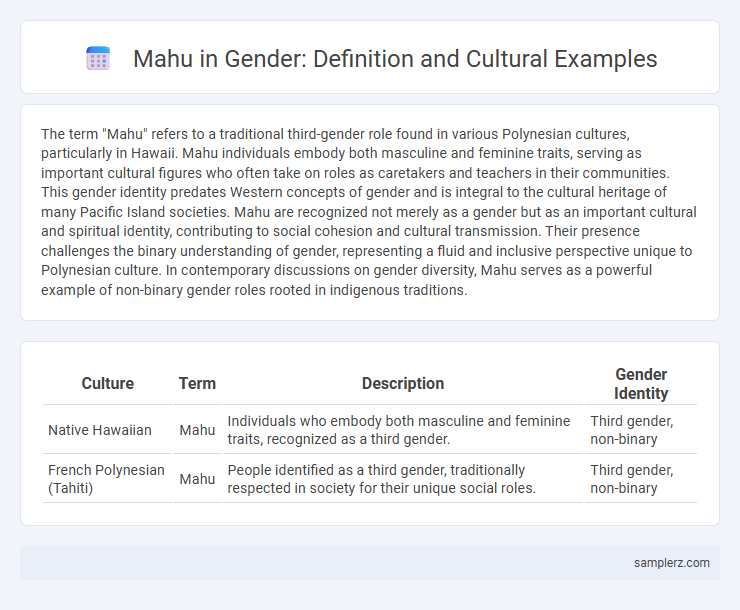The term "Mahu" refers to a traditional third-gender role found in various Polynesian cultures, particularly in Hawaii. Mahu individuals embody both masculine and feminine traits, serving as important cultural figures who often take on roles as caretakers and teachers in their communities. This gender identity predates Western concepts of gender and is integral to the cultural heritage of many Pacific Island societies. Mahu are recognized not merely as a gender but as an important cultural and spiritual identity, contributing to social cohesion and cultural transmission. Their presence challenges the binary understanding of gender, representing a fluid and inclusive perspective unique to Polynesian culture. In contemporary discussions on gender diversity, Mahu serves as a powerful example of non-binary gender roles rooted in indigenous traditions.
Table of Comparison
| Culture | Term | Description | Gender Identity |
|---|---|---|---|
| Native Hawaiian | Mahu | Individuals who embody both masculine and feminine traits, recognized as a third gender. | Third gender, non-binary |
| French Polynesian (Tahiti) | Mahu | People identified as a third gender, traditionally respected in society for their unique social roles. | Third gender, non-binary |
Understanding Mahu: A Third Gender in Polynesian Culture
Mahu represents a traditional third gender in Polynesian culture, embodying both masculine and feminine traits and playing vital social and spiritual roles. Historically respected as healers, teachers, and mediators, mahu individuals contribute significantly to cultural preservation and community cohesion. This recognition of gender fluidity challenges Western binary norms and highlights the diversity of human gender experiences.
Historical Significance of Mahu in Hawai'i and Tahiti
The mahu hold a revered place in Hawai'i and Tahiti as traditional third-gender individuals who embody dual male and female spirits, playing vital roles in cultural rituals and social structures. Historically, mahu were respected as caretakers, healers, and educators, bridging gender and spiritual realms while contributing to the preservation of indigenous knowledge and cultural heritage. Their presence challenges Western binary gender frameworks, highlighting the rich diversity and complexity of Polynesian gender identities and their impact on community cohesion.
Roles and Responsibilities of Mahu in Traditional Communities
In traditional Polynesian cultures, mahu individuals often serve as cultural educators, preserving and imparting sacred knowledge, ceremonies, and dances essential to community identity. Their roles extend to mediating social conflicts, guiding rites of passage, and maintaining spiritual balance within their communities. Mahu are revered as vital custodians of both gender diversity and cultural heritage, embodying a bridge between past traditions and contemporary societal values.
Mahu in Modern Society: Shifting Perceptions and Acceptance
Mahu individuals, traditionally recognized in Hawaiian culture as embodying both masculine and feminine traits, are increasingly visible in modern society, challenging rigid gender binaries and promoting inclusivity. Contemporary acceptance of Mahu reflects broader shifts towards recognizing diverse gender identities and fostering respect for cultural heritage within LGBTQ+ communities. This evolving perception supports mental health and social well-being by validating non-binary and gender-fluid experiences in both indigenous and global contexts.
Distinguishing Mahu from Western Gender Identities
The mahu identity in Native Hawaiian culture represents a traditional third-gender role embodying both masculine and feminine traits, distinct from Western gender binaries such as transgender or non-binary. Unlike Western gender concepts centered on individual identity and expression, mahu integrates spiritual, social, and familial functions within the community. Recognizing mahu highlights the cultural specificity of gender beyond the Western framework, emphasizing indigenous understandings of gender as fluid and interconnected with cultural heritage.
Representation of Mahu in Art, Media, and Storytelling
Mahu, a traditional third-gender identity in Native Hawaiian culture, is often represented in art and media through vibrant depictions that celebrate gender diversity and spiritual balance. Visual artworks, films, and literature emphasize Mahu figures as integral cultural symbols embodying both masculine and feminine qualities, challenging Western gender binaries. These representations contribute to broader understanding and respect for indigenous gender roles within contemporary storytelling and cultural preservation efforts.
Spiritual and Ceremonial Contributions of Mahu
Mahu hold a revered place in Polynesian culture, serving as spiritual intermediaries and ceremonial leaders who embody both masculine and feminine traits. Their roles in rituals and community events include chanting, dancing, and guiding sacred ceremonies that preserve ancestral wisdom. Through these spiritual contributions, mahu help maintain cultural continuity and strengthen social cohesion within their communities.
Challenges and Discrimination Faced by Mahu Individuals
Mahu individuals, recognized in Polynesian cultures as embodying both masculine and feminine traits, face significant challenges including social stigma and limited acceptance within both traditional and contemporary societies. Discrimination manifests in reduced access to employment, healthcare disparities, and exclusion from communal decision-making processes. Persistent cultural misunderstandings and legal marginalization further exacerbate the difficulties encountered by mahu people in affirming their identity and securing equal rights.
Mahu Voices: Personal Narratives and Experiences
Mahu represent a traditional third-gender identity in Native Hawaiian culture, embodying both masculine and feminine traits. Personal narratives from Mahu voices highlight their unique experiences navigating cultural acceptance and contemporary challenges in affirming gender identity. These stories enrich understanding of indigenous gender diversity and resilience within Pacific Islander communities.
Preservation and Revival of Mahu Heritage in Contemporary Culture
The preservation and revival of Mahu heritage in contemporary culture focus on safeguarding traditional gender identities rooted in Polynesian societies, particularly in Hawaii. Mahu individuals historically held respected social and spiritual roles, and current efforts include cultural education programs, art exhibitions, and community workshops that emphasize their significance. These initiatives aim to restore visibility and honor the Mahu legacy amidst modern challenges to gender diversity.

example of mahu in gender Infographic
 samplerz.com
samplerz.com